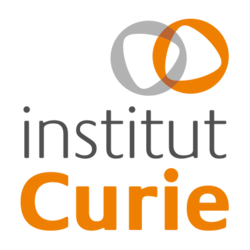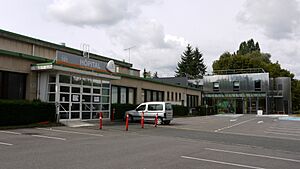Curie Institute (Paris) facts for kids
 |
|
| Formation | 1920 |
|---|---|
| Type | Government-supported organization |
| Purpose | Scientific and medical research |
| Headquarters | 26 rue d'Ulm 75005 Paris |
|
Official language
|
French |
|
President
|
Thierry Philip |
The Institut Curie (Curie Institute) is a world-famous research center in Paris, France. It was founded by the brilliant scientist Marie Curie. The institute is a private, non-profit organization that does two main things: it runs a research center and a hospital.
Scientists at the institute study biology and physics to understand life and diseases better. The hospital specializes in treating cancer. The Institut Curie is also part of EU-LIFE, a group of top European research centers working together to make new discoveries.
Contents
What Do Scientists Do at Institut Curie?
The institute is a busy place for scientific discovery. It works with other major French research groups like CNRS and INSERM. Hundreds of scientists work here.
While the Institut Curie doesn't give out university degrees like a normal college, it's a place where future scientists can earn their PhDs. A PhD is the highest degree a person can get in a field of study. Many young scientists also come here after getting their PhDs to continue their training. The institute is also a partner school of the University PSL.
A Special Hospital for Fighting Cancer
The Institut Curie runs a hospital called the Hôpital Claudius Régaud. This hospital is focused entirely on helping people with cancer.
One of the most advanced things the institute does is proton therapy. It has a special center in a town called Orsay, near Paris. Proton therapy is a very precise type of treatment that uses tiny particles called protons to attack cancer cells while doing less harm to the healthy parts of the body. There are only a few centers like this in the world.
The Story of the Curie Institute
The institute's story begins with one of the most famous scientists in history, Marie Curie.
The Radium Institute
In 1909, the University of Paris and the Institut Pasteur created a large laboratory for Marie Curie called the Institut du Radium (Radium Institute). It was split into two parts:
- The Curie laboratory, led by Marie Curie herself. Here, scientists studied physics and chemistry, especially radioactivity.
- The Pasteur laboratory, led by Dr. Claudius Regaud. This lab studied how radioactivity could be used in medicine.
Marie Curie had already won a Nobel Prize in Physics in 1903 with her husband, Pierre. In 1911, she won a second Nobel Prize, this time in Chemistry. During World War I, she used her knowledge to teach nurses how to use radiology (like X-rays) to help wounded soldiers.

A New Foundation and Hospital
In 1920, Marie Curie and Dr. Claudius Regaud started the Curie Foundation. Its goal was to raise money for the Radium Institute and to help build a hospital. The first hospital opened in 1922.
At this new clinic, Dr. Regaud and his team created new ways to treat cancer by combining surgery with radiation therapy. The Curie Foundation became a role model for cancer centers all over the world.
Meanwhile, the Curie laboratory continued to make amazing discoveries. In 1934, Marie Curie's daughter, Irène Joliot-Curie, and her husband, Frédéric Joliot-Curie, discovered artificial radioactivity. This earned them the Nobel Prize in Chemistry in 1935.
In 1970, the Radium Institute and the Curie Foundation joined together to become the Institut Curie we know today. Its mission is to research, teach, and treat cancer. The original building where Marie Curie worked is now the Musée Curie, a museum where you can learn about her life and work.
A Legacy of Nobel Prizes and Inspiring Women
The Institut Curie is connected to an amazing number of Nobel Prize winners.
- Marie Curie (Physics, 1903): She was the first woman ever to win a Nobel Prize.
- Marie Curie (Chemistry, 1911): She is one of the very few people to win two Nobel Prizes in two different sciences.
- Pierre Curie (Physics, 1903): He and Marie were the first married couple to win a Nobel Prize together.
- Irène Joliot-Curie (Chemistry, 1935): She and her mother, Marie, are the only mother-daughter pair to have both won Nobel Prizes.
- Frédéric Joliot-Curie (Chemistry, 1935): He and his wife, Irène, were the second married couple from the institute to win.
- Pierre-Gilles de Gennes (Physics, 1991): A more recent winner from the institute.
The institute has a special history of supporting women in science. Almost half of all French women who have won a Nobel Prize in science did their prize-winning research at the Curie Institute. Because of this, many people consider it one of the most important places in the world for pioneering women scientists.
Marie Curie was a mentor to over 45 women scientists from around the world. One of them was Marguerite Perey, who discovered the element francium.
Famous Scientists from the Institute
Many brilliant scientists have worked at the Institut Curie over the years. Some of the most famous include:
- Marie Curie
- Claudius Regaud
- Irène Joliot-Curie
- Frédéric Joliot-Curie
- Pierre-Gilles de Gennes
- Marguerite Perey
- Jeanne Ferrier
- Ștefania Mărăcineanu
- Raymond Grégoire
See also
 In Spanish: Instituto Curie para niños
In Spanish: Instituto Curie para niños


